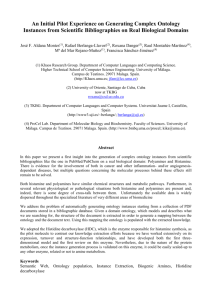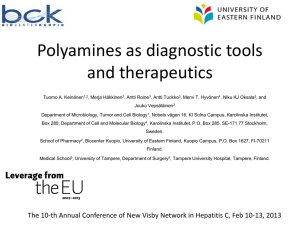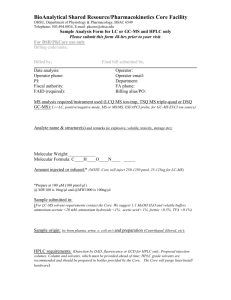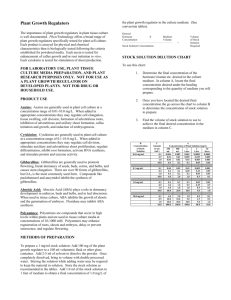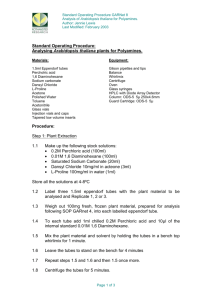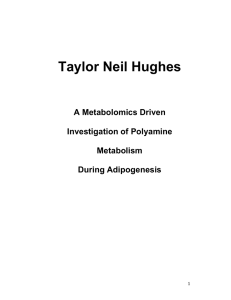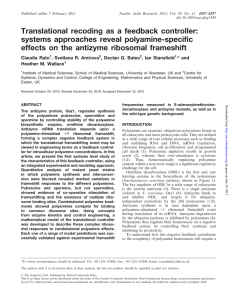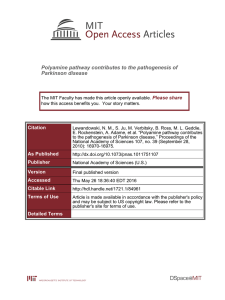Quantification of Polyamines Through High
advertisement
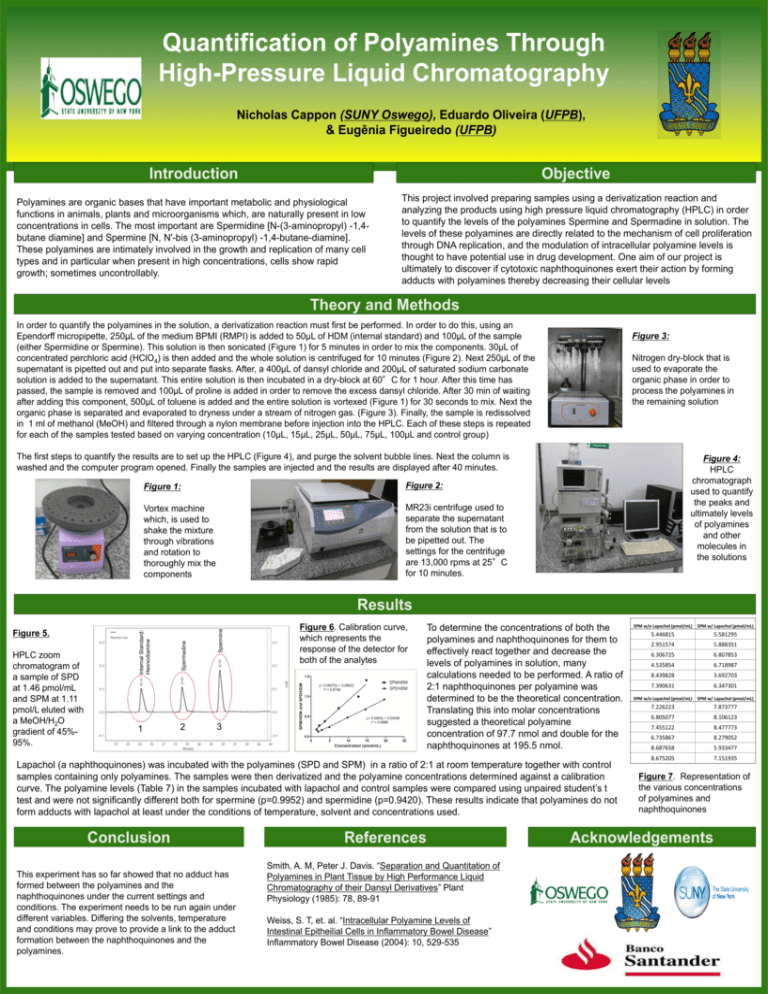
Quantification of Polyamines Through High-Pressure Liquid Chromatography Nicholas Cappon (SUNY Oswego), Eduardo Oliveira (UFPB), & Eugênia Figueiredo (UFPB) Introduction Objective Polyamines are organic bases that have important metabolic and physiological functions in animals, plants and microorganisms which, are naturally present in low concentrations in cells. The most important are Spermidine [N-(3-aminopropyl) -1,4butane diamine] and Spermine [N, N'-bis (3-aminopropyl) -1,4-butane-diamine]. These polyamines are intimately involved in the growth and replication of many cell types and in particular when present in high concentrations, cells show rapid growth; sometimes uncontrollably. This project involved preparing samples using a derivatization reaction and analyzing the products using high pressure liquid chromatography (HPLC) in order to quantify the levels of the polyamines Spermine and Spermadine in solution. The levels of these polyamines are directly related to the mechanism of cell proliferation through DNA replication, and the modulation of intracellular polyamine levels is thought to have potential use in drug development. One aim of our project is ultimately to discover if cytotoxic naphthoquinones exert their action by forming adducts with polyamines thereby decreasing their cellular levels Theory and Methods In order to quantify the polyamines in the solution, a derivatization reaction must first be performed. In order to do this, using an Ependorff micropipette, 250μL of the medium BPMI (RMPI) is added to 50μL of HDM (internal standard) and 100μL of the sample (either Spermidine or Spermine). This solution is then sonicated (Figure 1) for 5 minutes in order to mix the components. 30μL of concentrated perchloric acid (HClO4) is then added and the whole solution is centrifuged for 10 minutes (Figure 2). Next 250μL of the supernatant is pipetted out and put into separate flasks. After, a 400μL of dansyl chloride and 200μL of saturated sodium carbonate solution is added to the supernatant. This entire solution is then incubated in a dry-block at 60°C for 1 hour. After this time has passed, the sample is removed and 100μL of proline is added in order to remove the excess dansyl chloride. After 30 min of waiting after adding this component, 500μL of toluene is added and the entire solution is vortexed (Figure 1) for 30 seconds to mix. Next the organic phase is separated and evaporated to dryness under a stream of nitrogen gas. (Figure 3). Finally, the sample is redissolved in 1 ml of methanol (MeOH) and filtered through a nylon membrane before injection into the HPLC. Each of these steps is repeated for each of the samples tested based on varying concentration (10μL, 15μL, 25μL, 50μL, 75μL, 100μL and control group) Figure 3: Nitrogen dry-block that is used to evaporate the organic phase in order to process the polyamines in the remaining solution The first steps to quantify the results are to set up the HPLC (Figure 4), and purge the solvent bubble lines. Next the column is washed and the computer program opened. Finally the samples are injected and the results are displayed after 40 minutes. Figure 1: Figure 2: Vortex machine which, is used to shake the mixture through vibrations and rotation to thoroughly mix the components MR23i centrifuge used to separate the supernatant from the solution that is to be pipetted out. The settings for the centrifuge are 13,000 rpms at 25°C for 10 minutes. Figure 4: HPLC chromatograph used to quantify the peaks and ultimately levels of polyamines and other molecules in the solutions 1 2 Spermine HPLC zoom chromatogram of a sample of SPD at 1.46 pmol/mL and SPM at 1.11 pmol/L eluted with a MeOH/H2O gradient of 45%95%. Spermadine Figure 5. Internal Standard: Hexnodiamine Results Figure 6. Calibration curve, which represents the response of the detector for both of the analytes 3 To determine the concentrations of both the polyamines and naphthoquinones for them to effectively react together and decrease the levels of polyamines in solution, many calculations needed to be performed. A ratio of 2:1 naphthoquinones per polyamine was determined to be the theoretical concentration. Translating this into molar concentrations suggested a theoretical polyamine concentration of 97.7 nmol and double for the naphthoquinones at 195.5 nmol. Lapachol (a naphthoquinones) was incubated with the polyamines (SPD and SPM) in a ratio of 2:1 at room temperature together with control samples containing only polyamines. The samples were then derivatized and the polyamine concentrations determined against a calibration curve. The polyamine levels (Table 7) in the samples incubated with lapachol and control samples were compared using unpaired student’s t test and were not significantly different both for spermine (p=0.9952) and spermidine (p=0.9420). These results indicate that polyamines do not form adducts with lapachol at least under the conditions of temperature, solvent and concentrations used. Conclusion This experiment has so far showed that no adduct has formed between the polyamines and the naphthoquinones under the current settings and conditions. The experiment needs to be run again under different variables. Differing the solvents, temperature and conditions may prove to provide a link to the adduct formation between the naphthoquinones and the polyamines. References Smith, A. M, Peter J. Davis. “Separation and Quantitation of Polyamines in Plant Tissue by High Performance Liquid Chromatography of their Dansyl Derivatives” Plant Physiology (1985): 78, 89-91 Weiss, S. T, et. al. “Intracellular Polyamine Levels of Intestinal Epitheilial Cells in Inflammatory Bowel Disease” Inflammatory Bowel Disease (2004): 10, 529-535 SPM w/o Lapachol (pmol/mL) SPM w/ Lapachol (pmol/mL) 5.446815 5.581295 2.951574 5.888351 6.306725 6.807853 4.535854 6.718987 8.439828 3.692703 7.390631 6.347301 SPM w/o Lapachol (pmol/mL) SPM w/ Lapachol (pmol/mL) 7.226223 7.873777 6.805077 8.106123 7.455122 8.477773 6.735867 8.279052 8.687658 5.933477 8.675205 7.151935 Figure 7. Representation of the various concentrations of polyamines and naphthoquinones Acknowledgements
